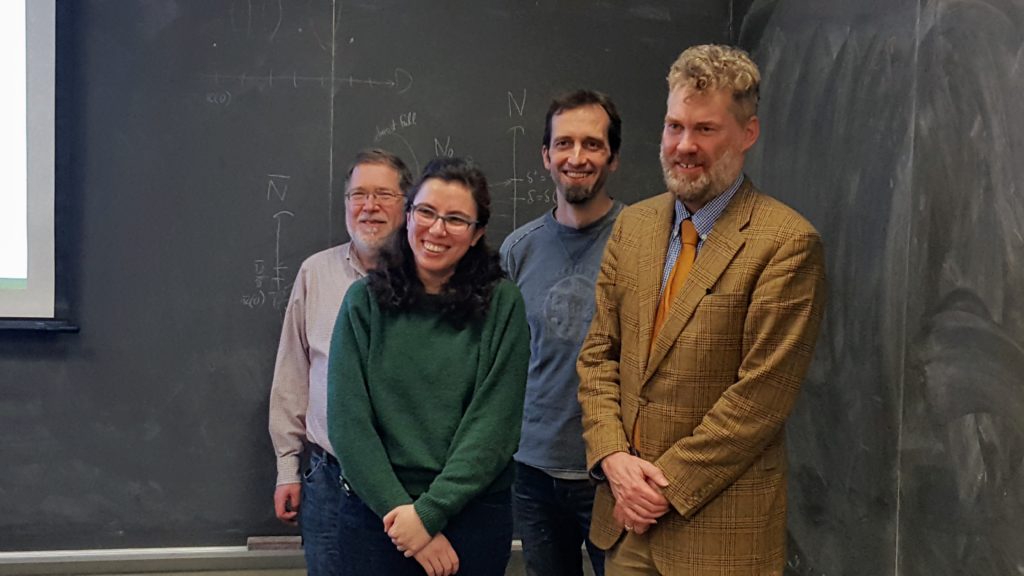Kaethe Lynn Bruesselbach Minden successfully defended her dissertation on April 7, 2017 at the CUNY Graduate Center, under the supervision of Professor Gunter Fuchs. I was a member of the dissertation committee, along with Arthur Apter.
Her defense was impressive! She was a master of the entire research area, ready at hand with the technical details to support her account of any topic that arose.
math blog | nylogic profile | ar
Kaethe Minden, “On Subcomplete Forcing,” Ph.D. dissertation for The Graduate Center of the City University of New York, May, 2017. (arxiv/1705.00386)
Abstract. I survey an array of topics in set theory and their interaction with, or in the context of, a novel class of forcing notions: subcomplete forcing. Subcomplete forcing notions satisfy some desirable qualities; for example they don’t add any new reals to the model, and they admit an iteration theorem. While it is straightforward to show that any forcing notion which is countably closed is also subcomplete, it turns out that other well-known, more subtle forcing notions like Prikry forcing and Namba forcing are also subcomplete. Subcompleteness was originally defined by Ronald Björn Jensen around 2009. Jensen’s writings make up the vast majority of the literature on the subject. Indeed, the definition in and of itself is daunting. I have attempted to make the subject more approachable to set theorists, while showing various properties of subcomplete forcing which one might desire of a forcing class.
It is well-known that countably closed forcings cannot add branches through
-trees. I look at the interaction between subcomplete forcing and 𝜔 1 -trees. It turns out that sub-complete forcing also does not add cofinal branches to 𝜔 1 -trees. I show that a myriad of other properties of trees of height 𝜔 1 as explored in [FH09] are preserved by subcomplete forcing; for example, I show that the unique branch property of Suslin trees is preserved by subcomplete forcing. 𝜔 1 Another topic I explored is the Maximality Principle (
). Following in the footsteps of Hamkins [Ham03], Leibman [Lei], and Fuchs [Fuc08], [Fuc09], I examine the subcomplete maximality principle. In order to elucidate the ways in which subcomplete forcing generalizes the notion of countably closed forcing, I compare the countably closed maximality principle ( M P ) to the subcomplete maximality principle ( M P < 𝜔 1 - c l o s e d ). Again, since countably closed forcing is subcomplete, this is a natural question to ask. I was able to show that many of the results about M P 𝑠 𝑐 also hold for M P < 𝜔 1 - c l o s e d ; for example, the boldface appropriate notion of M P 𝑠 𝑐 is equiconsistent with a fully reflecting cardinal. However, it is not the case that there are direct implications between the subcomplete and countably closed maximality principles. M P 𝑠 𝑐 Another forcing principle explored in my thesis is the Resurrection Axiom (
). Hamkins and Johnstone [HJ14a] defined the resurrection axiom only relative to R A , and focus mainly on the resurrection axiom for proper forcing. They also show the equiconsistency of various resurrection axioms with an uplifting cardinal. I argue that the subcomplete resurrection axiom should naturally be considered relative to 𝐻 𝔠 , and showed that the subcomplete resurrection axiom is equiconsistent with an uplifting cardinal. 𝐻 𝜔 2 A question reasonable to ask about any class of forcings is whether or not the resurrection axiom and the maximality principle can consistently both hold for that class. I originally had this question about the full principles, not restricted to any class, but in my thesis it was appropriate to look at the question for subcomplete forcing. I answer the question positively for subcomplete forcing using a strongly uplifting fully reflecting cardinal, which is a combination of the large cardinals needed to force the principles separately. I show that the boldface versions of
both holding is equiconsistent with the existence of a strongly uplifting fully reflecting cardinal. While Jensen [Jen14] shows that Prikry forcing is subcomplete, I long suspected that many variants of Prikry forcing which have a kind of genericity criterion are also subcomplete. After much work I managed to show that a variant of Prikry forcing known as Diagonal Prikry Forcing is subcomplete, giving another example of subcomplete forcing to add to the list. M P 𝑠 𝑐 + R A 𝑠 𝑐
Kaethe has taken up a faculty position at Marlboro College in Vermont.









